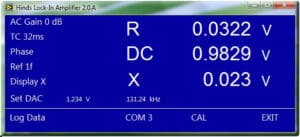The Signaloc 2100 Lock-In Amplifier (LIA) was originally designed for demodulation of PEM signals in Hinds’ internally developed Exicor® line of high performance birefringence measurement instrumentation. The goal was to match the sensitivity of popular commercially available lock-in amplifiers while minimizing extraneous functions to keep the cost down. The resulting Signaloc lock-in amplifier exceeded all expectations.
Tests were performed to compare the performance of the Signaloc 2100 to that of two leading lock-in amplifiers well known in research labs: the EG&G 7265 and Stanford Research SR830. All tests were performed with the input coming from an HP33120A Waveform Generator with its output signal divided down to yield an R value of ~ 130µV. All tests showed that the accuracy of the Signaloc 2100 was practically equal to both of the other Lock-In Amplifiers. The tests further revealed that the R value standard deviation of the Signaloc 2100 was marginally greater than the other two at very low time constants (i.e., low filtering) but similar to the other two when higher time constants ( i.e., more filtering) were used with the Signaloc LIA.
Given the success of the Signaloc LIA in the Hinds Exicor systems, we offer the Signaloc 2100 to Hinds customers who are developing their own bench top PEM-based systems for research applications as well as to our OEM customers for commercial applications. The key selling points are simplicity, small footprint, and price point – starting at US$1700.00 (US domestic).
The instrument is configured as shown in Figure 1. It is a small box with a footprint (the actual size is 22.5cm x 16.0cm x 32cm or 8.9 in x 6.3 in x 12.6 in) and weight (0.73 kg or 1.6 lbs) significantly less than those of the more expensive lock-ins. The amplifier is calibrated in the factory to lock-in to the 1f and 2f frequencies of the user’s PEM or other device. There are band pass filters for both frequencies. The unit measures and displays the AC magnitude of the signal in Volts RMS, the DC magnitude of the signal in Volts, and the frequency of the reference signal in kHz.
The display is virtual, as shown in Figure 2. Information is sent from the lock-in amplifier to a computer via RS-232 where it is displayed and available for immediate, real-time analysis by the user’s program.
Figure 1
Figure 2
Hinds Instruments, Inc. develops and manufactures photoelastic modulator-based systems and components that utilize the high sensitivity of PEM polarization analysis technology. This capability has become integral to a wide variety of applications involving measurement of such parameters as birefringence, Stokes polarimetry, dichroism, optical rotation and others in research, metrology and on-line environments. Founded in 1971 and located in Hillsboro, Oregon, Hinds has grown to become the world’s leading supplier of photoelastic modulators (PEMs) and systems. Hinds strives to provide advanced polarization modulation analysis technology, delivering solutions to customers that meet or exceed their real-world requirements. For more information please contact Hinds Instruments or sales@hindsinstruments.com.
© 2011 Hinds Instruments, Inc. All rights reserved.


